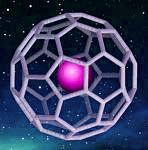
Buckyballs

The value of a reference interview looms large for this question, but when faced with no clue at all, the best place to start is by using a dictionary. However, the word 'buckyballs' could not be found in a number of them, including the Collins English Dictionary. The next step was to use the Internet. Entering the word 'buckyballs' provided an amazing amount of interesting information. It was immediately apparent that this was a science and technology question.
One thing to point out here is the great value the Internet plays in the dissemination of scientific information. It really was the explosion in the field of science after World War II and the need for quick access to this information in the scientific community that was the impetus for the Internet. Scientists have it used it from its inception to exchange ideas and new discoveries. One must still use caution when directing a patron to a scientific website, but they can be another good place to start.
In this case, a Scientific American webpage was the first hit, and it provided information on the subject of buckyballs, as well as the name of the lead scientist in the field. Richard Smalley, who, along with colleagues Robert Curl, Jim Heath, Sean O'Brien, and the person who wrote the first article on buckyballs, Harold Kroto, discovered this important new form of carbon in the 1980s during experiments aimed at understanding the mechanisms by which long chain carbon molecules are formed in interstellar space. The webpage also provided the name of the first article published on the topic and a link to Richard Smalley's homepage at Rice University where he was a professor of Physics and Chemistry. His site (http://smalley.rice.edu) had a list of his articles, including the one we are interested in for this question: C 60: Buckminsterfullerene. Finally, the other important piece of information retrieved from my search was the proper name for buckyballs, which is Buckminsterfullerenes. They were named after the geodesic dome because of its similar shape, an architectural design invented by Buckminster Fuller. I also learned that in 1996, Smalley, Curl, and Kroto were awarded the Nobel Prize in Chemistry for their 1985 discovery of the buckminsterfullerene.
Once I knew it was a science question, a perusal of dictionaries and encyclopaedias specializing in the discipline seemed to be the next best step in the search strategy. There are some very good ones being published. For instance, The New York Public Library Science Desk Reference had two entries on buckyballs. The curious carbon chemical whose chemical name is C 60 consists of sixty carbon atoms and resembles a soccer ball. This is the reason why a university soccer team would use the word buckyballs as the moniker for a soccer team. The players would most likely be from chemistry or physics departments, or scientists of some sort.
Another good quick reference tool for this question is The Gale Encyclopedia of Science, which has a nice two page entry explaining who discovered it, why it is so important, and possible uses. Finally, the Dictionary of Scientific Literacy by Richard P. Brennan has a small entry on buckyballs, providing enough information to get a patron going in the right direction. Referred to in scientific literature as C60, buckyballs are microscopic spheres of 60 atoms of pure carbon in a structure that resembles an exotic soccer ball. Before the discovery of buckyballs, carbon was most commonly thought of in two of its naturally occurring forms: graphite and diamonds.
Buckyballs represent a third form of carbon. As Craig Segawa writes,
Perhaps the most exciting characteristic of the buckyball is that it is hollow on the inside, and Smalley insists that all elements in the periodic table will fit inside. This could create any number of practical uses, the most notable being in the field of medicine. Drugs could be administered molecularly, or more importantly, individual radioactive molecules could be contained within the buckyball for specific treatment of cancer, compared to chemotherapy, which bombards the patient with low level (yet relatively large quantities of) radiation (Segawa).
At first glance, this question seemed very complicated. I had recently been doing some follow-up questioning of reference librarians for a research study and it is surprising how many of them have said that questions that seem to be the easiest, often end up being the hardest in the long run. Questions like this one on buckyballs, which seemed difficult at the beginning, involve very few steps and are basically ready reference questions that are easily answered. It is always important to remember this kind of thing when librarians work on reference desks. Make sure you consider each question carefully, and get as much information as you can from the patron. Also, use the resources that are at the reference desk because they are often the best place to start.
Since the lead researchers for Buckminsterfullerenes, as well as a large number of scientists around the world, are continuing to make breakthroughs, find uses for, and cheaper ways to manufacture this expensive form of carbon, there is a large amount of information available for an interested patron. Besides the Internet, there are countless numbers of journal articles and many scholarly books such as Electronic Structure Calculations on Fullerenes and their Derivatives by Jerzy Cioslowski, for the more advanced.
Related Papers
Literature Searching for Library School StudentsBames Svarney, Patricia, ed. 1995. The New York Public Library Science Desk Reference. New York: Macmillan.
Brennan, Richard P. 1992. Dictionary of Scientific Literacy. New York: John Wiley & Sons, Inc.
Davidson, Michael W. 1998. The Buckyball Collection. Available: http://micro.magnet.fsu.edu/micro/gallery/bucky/bucky.html
Kroto, H.W. et al. 1985. C 60: Buckminsterfullerene. Nature 318: 162-163.
Nanotechnology: Scoring with Buckyballs. Scientific American. August 20, 1993.
Segawa, Craig. The Buckyball: An Excruciatingly Researched Report. Available: http://www.insite.com.br/rodrigo/bucky/buckyball.txt
Travers, Bridget, ed. 1995. The Gale Encyclopedia of Science. New York: Gale Research.